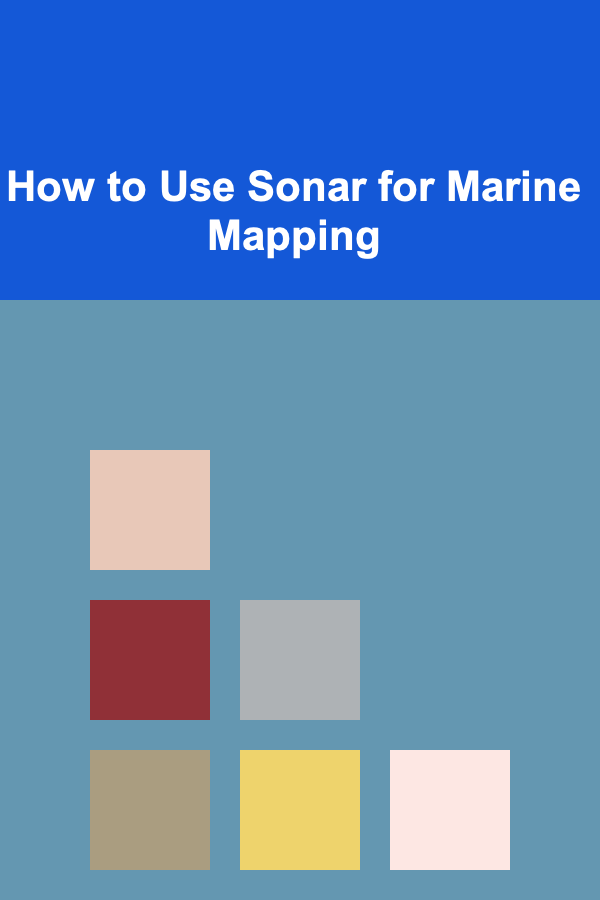
How to Use Sonar for Marine Mapping
ebook include PDF & Audio bundle (Micro Guide)
$12.99$8.99
Limited Time Offer! Order within the next:

Marine mapping, the process of surveying the seabed and underwater environments, is critical for various industries such as marine biology, navigation, fisheries, offshore oil exploration, and environmental monitoring. One of the most important technologies used in marine mapping is sonar (Sound Navigation and Ranging). Sonar systems allow us to "see" beneath the surface of the water, enabling us to create detailed maps of the seafloor, identify underwater features, and monitor the underwater environment.
This article explores the science behind sonar technology, how it is applied in marine mapping, the types of sonar systems used, and the practical steps involved in using sonar for marine mapping.
The Science Behind Sonar
Sonar technology works on the principle of sound waves and their interactions with underwater objects. Just like how bats use echolocation to navigate, sonar systems use sound waves to detect objects in water. When a sonar signal is emitted, it travels through the water until it encounters an object or the seafloor. The sound wave then bounces back, and the sonar system records the time it took for the wave to return. This time difference allows the system to calculate the distance to the object or the seabed, which is then used to create a representation of the underwater environment.
There are two primary types of sonar used in marine mapping:
- Active Sonar: This system emits sound waves into the water and listens for the reflected waves. Active sonar is widely used for marine mapping because it can provide both the distance and the shape of the objects or seafloor.
- Passive Sonar: This system only listens for sound waves emitted by other sources, such as submarines or marine life. While passive sonar is useful for detecting sounds, it is not commonly used for mapping the seafloor.
The effectiveness of sonar systems depends on the frequency of the sound waves. Higher frequencies provide better resolution but have limited range, while lower frequencies have longer ranges but less detail.
Types of Sonar Systems Used for Marine Mapping
Marine mapping requires specific sonar systems depending on the needs of the project. The two most commonly used sonar systems for marine mapping are single-beam sonar and multi-beam sonar.
1. Single-Beam Sonar
Single-beam sonar is one of the oldest and simplest forms of sonar technology. This system emits a single sound pulse vertically downwards and measures the time it takes for the pulse to return after striking the seafloor. The depth is then calculated based on the time delay. Single-beam sonar is relatively simple, cost-effective, and suitable for shallow-water mapping.
Applications of Single-Beam Sonar:
- Shallow water depth surveys
- Nautical charting
- Fishery surveys
- Bathymetric mapping for small projects or localized areas
2. Multi-Beam Sonar
Multi-beam sonar systems use multiple sound waves emitted in a fan-shaped pattern across a wider area. This technology provides more detailed data and allows for the creation of high-resolution, 3D maps of the seafloor. Multi-beam sonar is especially useful for large-scale mapping of deep-sea environments and areas with complex topography.
Applications of Multi-Beam Sonar:
- High-resolution mapping of the ocean floor
- Offshore oil and gas exploration
- Marine habitat monitoring
- Underwater archaeology and geological surveys
3. Side-Scan Sonar
Side-scan sonar operates differently from both single-beam and multi-beam systems. Instead of emitting sound waves directly beneath the device, side-scan sonar sends out waves at an angle to the side of the boat or vehicle, creating a "side view" of the seabed. This system is particularly useful for detecting underwater structures, wrecks, and other submerged objects.
Applications of Side-Scan Sonar:
- Mapping underwater wrecks and archaeological sites
- Detecting underwater hazards for navigation
- Search and rescue operations
- Surveying habitats in shallow and deep water
4. Sub-Bottom Profilers
Sub-bottom profilers are specialized sonar systems used to map layers beneath the seafloor. These systems send low-frequency sound waves deep into the ground, allowing them to penetrate sediment layers and reveal subsurface features. Sub-bottom profiling is often used in geological surveys and for locating buried pipelines or cables.
Applications of Sub-Bottom Profilers:
- Geotechnical investigations
- Seismic hazard assessment
- Underwater archaeology
- Locating buried infrastructure
How Sonar is Used for Marine Mapping
Using sonar for marine mapping involves several steps, from equipment setup to data processing and interpretation. The process can vary depending on the specific sonar system and the purpose of the mapping project, but the general steps remain largely the same.
Step 1: Planning the Survey
Before starting a sonar survey, proper planning is essential. Key considerations include:
- Survey Area: Determine the size and location of the area to be surveyed.
- Mapping Purpose: Understand the goal of the mapping project. For example, is it for navigation, ecological monitoring, or infrastructure planning?
- Depth and Terrain: Different sonar systems are suited for specific depths and types of terrain. For example, multi-beam sonar is ideal for deep-water mapping, while single-beam sonar is more suitable for shallow waters.
- Environmental Conditions: Consider factors such as water clarity, temperature, salinity, and weather conditions, as they can affect sonar performance.
Step 2: Choosing the Right Sonar System
Based on the survey requirements, you need to choose the appropriate sonar system. Some systems are better for high-resolution shallow-water mapping, while others excel at deep-sea mapping or long-range surveys. For large-scale mapping of the ocean floor, a multi-beam sonar system is typically the best choice, while side-scan sonar is ideal for locating underwater structures and wrecks.
Step 3: Deploying the Sonar Equipment
Once the survey area and sonar system are determined, the next step is deploying the sonar equipment. Sonar systems can be mounted on various platforms depending on the type of survey being conducted:
- Vessel-mounted Sonar: For surveys in large bodies of water, sonar equipment is typically mounted on ships, boats, or autonomous surface vehicles.
- Remotely Operated Vehicles (ROVs): In deeper waters or for more detailed surveys, ROVs equipped with sonar sensors are used.
- Autonomous Underwater Vehicles (AUVs): AUVs are self-propelled, autonomous systems that can map large areas without requiring direct human intervention. These vehicles are equipped with various sensors, including sonar, to collect data on the seafloor.
Once deployed, the sonar system emits sound waves in a specific pattern and listens for the echoes that bounce back from the seafloor or underwater objects.
Step 4: Data Collection
During the survey, sonar systems continuously collect data on the distance between the device and the seafloor or underwater objects. In the case of multi-beam and side-scan sonar, multiple sound waves are emitted at once, providing a continuous stream of data across a wide area.
The data collected by the sonar system is typically stored in a raw format that needs to be processed to create usable maps. This data may include depth information, the shape of the seafloor, and images of submerged structures or objects.
Step 5: Data Processing
After the data has been collected, it needs to be processed to generate meaningful maps. The raw sonar data is typically processed using specialized software that can convert the data into visual representations of the seafloor. Some of the techniques involved in processing sonar data include:
- Bathymetric Mapping: The creation of maps showing the depth of the ocean floor. Multi-beam sonar data is often used to create high-resolution bathymetric maps.
- 3D Modeling: Sonar data can be converted into 3D models of the seafloor or underwater structures, allowing for detailed visualizations and analysis.
- Side-Scan Sonar Imaging: Side-scan sonar data can be processed into images of the seafloor, highlighting underwater features and objects.
Advanced software also allows for the integration of different types of sonar data, enabling a comprehensive view of the surveyed area. The resulting maps and models can then be used for analysis, decision-making, and reporting.
Step 6: Data Interpretation and Reporting
Once the sonar data has been processed into maps or 3D models, marine scientists, engineers, and planners analyze the results. This interpretation might involve identifying underwater features, measuring the topography of the seabed, or assessing the suitability of a location for construction, such as an offshore oil platform or underwater pipeline.
Reports are then generated based on the findings, which may include recommendations for further study or actions. These reports can be used by various stakeholders, including environmental organizations, government agencies, and private companies.
Challenges in Using Sonar for Marine Mapping
While sonar technology has revolutionized marine mapping, it does come with its challenges. Some of the primary difficulties include:
- Environmental Factors: Water temperature, salinity, and turbidity can affect the propagation of sound waves, leading to inaccurate data.
- Data Processing: The sheer volume of data collected during marine surveys can be overwhelming. Processing and interpreting sonar data requires sophisticated software and skilled personnel.
- Cost: High-quality sonar systems, especially multi-beam sonar and AUVs, can be expensive to acquire and operate.
- Regulatory Concerns: In some regions, sonar mapping may require permits or adherence to environmental regulations to ensure the protection of marine life and ecosystems.
Conclusion
Sonar is an indispensable tool for marine mapping, offering the ability to visualize and understand the underwater world in ways that were once impossible. From bathymetric mapping to detecting underwater structures, sonar provides essential data for a variety of industries, from marine biology to offshore engineering. By selecting the appropriate sonar system, carefully planning the survey, and processing the collected data, sonar technology allows for the creation of detailed, accurate maps of the seafloor and submerged environments.
As technology continues to advance, the future of sonar in marine mapping looks even more promising. With improvements in sonar systems, data processing, and autonomous platforms, we can expect to see even greater advancements in underwater exploration and mapping in the years to come.

How to Clean and Maintain Your HVAC System for Optimal Performance
Read More
How to Incorporate Sustainable Lighting Options into Your Home
Read More
How to Save for a Home Purchase in a Competitive Market
Read More
How to Start Utilizing Free or Discounted Public Transportation Programs in Your Area
Read More
How to Use Lighting to Create a Calm and Relaxing Atmosphere
Read More
The Warehouse Manager's Guide: Mastering Inventory Management and Operational Efficiency
Read MoreOther Products

How to Clean and Maintain Your HVAC System for Optimal Performance
Read More
How to Incorporate Sustainable Lighting Options into Your Home
Read More
How to Save for a Home Purchase in a Competitive Market
Read More
How to Start Utilizing Free or Discounted Public Transportation Programs in Your Area
Read More
How to Use Lighting to Create a Calm and Relaxing Atmosphere
Read More